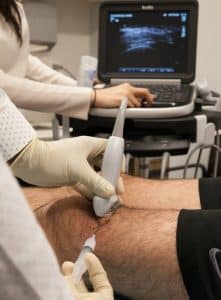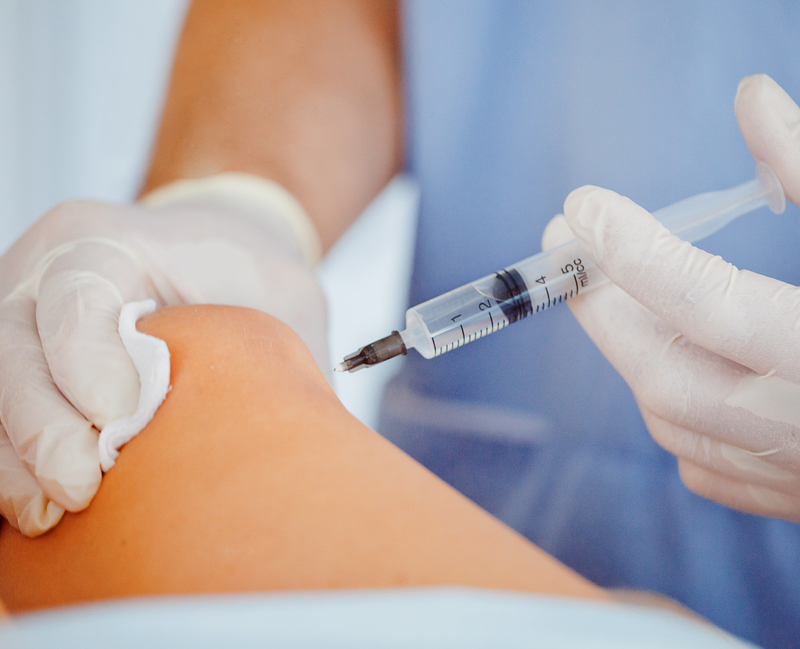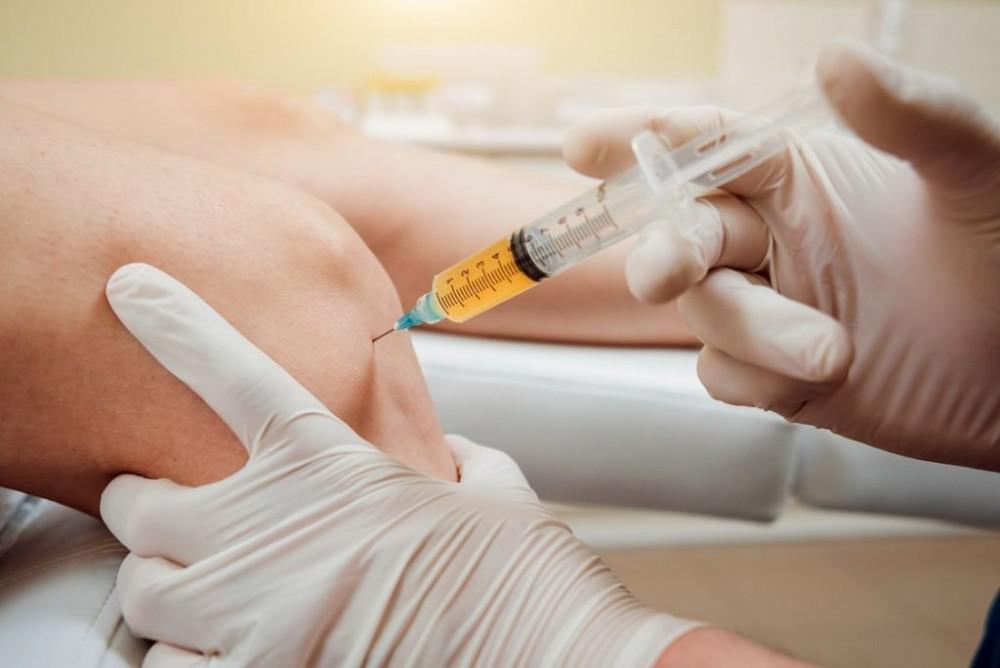Many conditions can cause chronic pain—musculoskeletal disorders, sports or work injuries, cancer, inflammatory diseases, joint diseases, and overuse injuries among other painful conditions.
Ultrasound-Guided Injections are an advanced therapeutic technique for managing chronic pain, injuries, and joint disorders. This injection treatment delivers medication directly to the source of your pain with precision and accuracy.
Hyaluronic acid injections for pain, steroids, and lidocaine can be injected into injured tissue, joints, and tendons, to suppress inflammation, induce healing, and speed up recovery. They’re an excellent alternative for surgery and carry much fewer risks.
Dr. Sardar, the pain management doctor, is one of the top pain management specialists in Brooklyn, New York. He expertly performs ultrasound-guided injections to treat different musculoskeletal disorders and -in many cases- cure chronic pain. So far, Dr. Sardar has treated many patients looking for a way to live pain-free.
Keep reading to learn more about ultrasound-guided injections, how it works, and why you may need them.
What Are Ultrasound-Guided Injections?
Most times, pain is caused by inflammation in the tissues, a swelling in the joint, or a bodily malfunction that needs immediate treatment. Advancements in technology have given rise to various treatment techniques that significantly reduce pain.
Ultrasound-Guided Injections are a pain management technique wherein medications are injected directly into the painful area with ultrasound assistance. The ultrasound is an imaging device that uses sound waves to produce real-time images of the structures in your body.
This means that Dr. Sardar, pain management specialist in Brooklyn, NY, will be seeing the needle on a screen in real-time as it penetrates the muscles, and will guide the needle accordingly to target the primary source of pain.
This advanced injection therapy prevents the hit-or-miss approach and delivers pain relief directly to the target area.
Dr. Sardar may use the ultrasound to guide injections into:
- Bursae – The bursae are fluid-filled sacs usually found between near joints. They reduce friction between the muscle, tendons, and bones. When the bursa becomes inflamed (bursitis), it might cause joint pain and loss of joint function. Guided steroid injections can help reduce inflammation and treat bursitis.
- Nerves – Nerves are involved in all painful conditions. They transmit pain signals to the brain. In chronic conditions, they’re under constant stimulation. Dr. Sardar might inject lidocaine, a local anesthetic, at nerve roots to effectively block them from transmitting pain. This is called a nerve block, and it can suppress stubborn chronic pain in any body region.
- Tendons – Tendons might become inflamed due to overuse, inflammation, or injury (a condition called tendinitis). Steroid injections, with the help of ultrasound guidance, can relieve inflammation and pain from tendon disease.
- Muscles – Muscle injuries and strains can sometimes become painful. Dr. Sardar can accurately target deep muscle fibers to numb the pain with a combination of medications.
- Joints – To treat inflammatory and degenerative joint diseases (arthritis, arthrosis) as well as joint injuries. Dr. Sardar injects steroids, lidocaine, and/or hyalgan in and around the joint capsule to reduce pain, encourage healing, and restore function to the joint.
What Are the Different Types of Ultrasound-Guided Injections?
Ultrasound-guided injection therapy isn’t a singular treatment plan. Dr. Sardar can administer different types of injection therapies with the help of ultrasound.
Viscosupplementation Injections
Viscosupplementation makes use of hyaluronic acid (hyalgan) to treat pain occurring in your joints. Hyaluronic acid naturally occurs in the fluid surrounding your joints. It acts as a lubricant and a shock absorber for heavy joint loads. Viscosupplementation injections commonly treat knee or shoulder osteoarthritis – a degenerative disease of the joints. It restores lubrication and thus reduces pain in the joint and prevents any future damage.
Corticosteroid Injections
Ultrasound-guided corticosteroid injections treat pain caused by inflammatory diseases. Corticosteroids reduce inflammation and regulate the immune response, putting a halt to tissue damage from chronic and acute injuries.
The steroid shot offers quick relief from varying conditions like back pain, bursitis, and tendinitis.
Corticosteroid injections include methylprednisolone, prednisone, and cortisone, the latter being the most common injection.
Lidocaine Injections
Lidocaine is a local anesthetic. It numbs the pain receptors and prevents them from transmitting pain signals to the pain centers in the spinal cord and brain.
Dr. Sardar uses ultrasound to inject lidocaine into specific nerve-rich points around the painful area. This allows him to block the nerve supply in the whole treated region, rendering it painless and insensible for hours or days.
How Do Ultrasound-Guided Injections Work?
An ultrasound-guided injection delivers pain-relieving medication to injured tissue with utmost precision. At our pain management clinic, we often administer lidocaine and cortisone to ease pain and inflammation and restore motor function.
The medications are used to trigger a series of biological processes that produce localized pain relief and healing. Here are some of their effects:
- Anti-inflammation: Ultrasound-guided injections can be used to reduce inflammation and subsequently diminish pain. When the injections are delivered, they block inflammatory mediators and regulate the immune response. The result is a decrease in pain and swelling.
- Nerve Blocks: Chronic pain can be soothed through nerve block injections. The injections block sympathetic nerves that send out pain signals to the brain. As a result, it elicits an anesthetic effect on the treated region of your body, significantly reducing the pain.
- Lubrication: Hyaluronic acid injections provide natural lubrication in diseased joints. This reduces friction and injury, promotes healing, and reduces pain from the rubbing naked bone surfaces.
What Conditions Do Ultrasound-Guided Injections Treat?
Ultrasound-guided injections have become the therapy of choice for various conditions, ranging from inflammatory disorders to nerve impingement.5 It has an advantage in treating an array of painful chronic diseases because of precise delivery and reduced risks.

At PainTherapy Medical Care, Dr. Henry Sardar frequently uses ultrasound-guided injections to treat these conditions.
Musculoskeletal disorders:
- Epicondylitis
- Tendonitis
- Carpal Tunnel Syndrome
- Ligament sprain
- Tension neck syndrome
- Rotator cuff tendonitis
- Neck pain
- Joint pain
- Radicular pain
- Low back pain
- Subacromial bursitis
- Trochanteric bursitis
- Knee pain
- Shoulder pain
- Arthritic joints of the hand and fingers
- Ankle joint
If you are considering ultrasound-guided injection as a treatment for your painful condition, Dr. Sardar is giving you the chance to test this treatment and discover the benefits. Set a pain relief appointment today.
Am I A Candidate For Ultrasound-Guided Injections?
If you’re fed up with relying on painkillers that only provide temporary relief, you’ll likely benefit from an ultrasound-guided injection.
Osteoarthritis, frozen shoulder, tennis elbow, rotator cuff syndrome, and other conditions can all be treated with ultrasound-guided injections.
Anyone can avail of ultrasound-guided injections to remedy their chronic conditions. Real-time imaging provides this technique with a high level of accuracy and efficacy that eases various painful disorders.
Ultrasound-guided injections might be the treatment for you if:
- You have an inflammatory or degenerative joint disease (e.g. osteoarthritis)
- You have an overuse muscle, joint, or bone injury (e.g. rotator cuff syndrome)
- You’ve been experiencing persistent chronic pain for several weeks or months
- You want fast relief from post-operative pain
- You have inflammatory conditions that are resistant to anti-inflammatory medication
- You want to explore alternative treatment options and avoid surgical procedures
Despite the growing popularity of ultrasound-guided injections, it may not be a suitable treatment for everybody. The injections may elicit adverse effects in the following cases:
- Active infections
- Lidocaine and steroid allergies
If you fall under any of the contraindications listed above, don’t worry. We offer several specialized therapy services at our pain clinic.
Give us a call to find the right pain-relief plan for you.
What Are The Benefits Of Ultrasound-Guided Injections?
Ultrasound-guided injections have been proven to be a safe and minimally invasive treatment for chronic pain. Most patients prefer this over conservative therapies because of the long-lasting relief it elicits in such a short time.
These are some of the reasons Ultrasound-Guided Injections are becoming increasingly popular among Dr. Sardar’s patients in New York:
- Fast pain relief: Ultrasound-guided injections treat the pain at its source. The therapeutic effects are localized and very accurate, allowing for almost immediate relief.
- Long-lasting effects: Ultrasound-guided injections provide long-lasting pain-relief that can last days or weeks. They promote anti-inflammatory pathways, the production of growth factors, and regeneration in your injured tissue.
- No hit-or-miss: Ultrasound imaging directs the needle to hit the target just right with minimal guesswork. Dr. Sardar will see the needle and guide it in real-time with the help of the ultrasound device.
- Minimally invasive: If you wish to avoid surgery, steroid, hyalgan, and lidocaine injections can be an excellent alternative. They can reduce pain, promote healing, and restore function to your joints.
How Are Ultrasound-Guided Injections Administered?
Dr. Sardar, pain management doctor, near you in Brooklyn will first perform a preliminary scan of the target area using the ultrasound probe. For that, ultrasound gel is applied on your skin for the probe to glide.
Dr. Sardar will use the ultrasound to get a precise location of where he will insert the needle. Once he locates the area, he will disinfect your skin with an antiseptic solution.
With one hand, Dr. Sardar will hold the ultrasound probe on your body to see the treated area. On the other hand, He will advance the injection needle through your muscle and directly into the target structure (e.g. bone, nerve, joint, tendon).
Usually, we use a combination of steroids and local anesthetic to relieve the pain and numb the treated area. The needle is sized anywhere between 25 to 27-gauge.
In addition to injecting medications, Dr. Sardar may extract any inflammatory fluid present in the area of your pain.
During the procedure, you’ll feel a little pressure as the needle pricks your skin, but that’s about it. The procedure lasts between 5 to 10 minutes, and there is very little preparation before or after the appointment. If everything goes smoothly you’re free to go home right after the procedure.
Can Ultrasound-Guided Injections be Combined with Other Procedures?
Absolutely. You can combine ultrasound-guided injections with the other pain management treatments at our clinic. At your consultation, Dr. Sardar can draft a treatment plan to help you achieve effective pain management and healing.
Some therapies that Dr. Sardar often combines include:
- Cold laser therapy
- Shock-wave therapy
- Cryotherapy
- Kinesiology taping
- Electromagnetic Transduction therapy (EMTT)
- TECAR Therapy
- Platelet-rich plasma (PRP) therapy
- Perineural Injection Therapy (PIT)
- Acupuncture Therapy
- Aqua therapy
- Fluoroscopically Guided Epidural Steroid Injection and Facet Injection
- Physical and Occupational Therapy
You don’t have to keep relying on unsuccessful methods when there are so many tried-and-tested therapies for chronic pain right here in Brooklyn, New York. Visit us today at PainTherapy Medical Care, Brooklyn, New York it may be just what you need for a long-lasting solution to your condition.
What Happens After Ultrasound-Guided Injections?
Ultrasound-guided injection therapy reduces the impact of chronic pain significantly. Once you’ve received the shot, you may notice reduced inflammation, improved muscle and joint function, and overall less discomfort in the painful area.
The pain relief from the injection can last for a few weeks up to several months depending on the condition and the individual patient. You can repeat injection therapy as medically necessary. However, we urge you to combine it with our other pain treatments to heighten and prolong the therapeutic effects.
After your injections, you’re free to continue your daily routine without the exhausting pain. No need to miss work or stay at home for a long time.
Are Ultrasound Guided Injections Covered By Insurance?
In many cases, US-guided injections are covered by insurance. If your primary care physician, orthopedist, physical therapist, or orthopedic surgeon recommends this pain therapy, then it will likely be eligible for coverage.
We accept most major insurance providers at our Brooklyn pain clinic: New York State Medicaid, HealthFirst, Fidelis Care, Affinity Group, Metro Plus, Amerigroup, BlueCross / BlueShield Medicaid Plan, and United Health Care Community Plan are welcome.
Dr. Sardar has seen the success of US-guided injections among his patients. He trusts that guided injections can be just what some patients need to heal from chronic painful conditions. This is why he’s now recommending ultrasound-guided injections for all his patients struggling with chronic persistent pain.
Outlook
Dealing with constant pain can be frustrating. You’re missing out on special occasions, opportunities, and activities you enjoy. Recent studies reveal that 84% of people with chronic pain conditions can’t work outside their homes. Chronic pain can limit you and decrease your overall quality of life. However, there’s always a solution.
Contact us or visit us at PainTherapy Medical Care to kick-start your body’s fast pain relief and recovery.
FAQs
- How long does an ultrasound-guided injection take? The typical length for each session can range from 5 to 10 minutes. There is little pre- and post-appointment preparation for the procedure.
- Is injection therapy painful? Guided injections are not especially painful. All you will feel is a slight prick when the injection is delivered.
- How soon after my ultrasound-guided injection can I go to work? Guided injections usually have minimal downtime. You can usually go back to work the same or the next day after your injections and don’t need extended time off.
- Can I walk after a cortisone injection in my foot? A cortisone injection only needs about 5 minutes to kick in after you get the steroid shot. You can walk around shortly afterward.
- What is the best injection for alleviating pain? Paraspinal lidocaine and steroid injection are one of the most common and most recommended pain management injections. Alternatively, lidocaine injections can be used on peripheral tissue to perform a nerve block and numb the whole area.
- Do I need anesthesia for ultrasound-guided injections? This depends on each patient and on the treated area. Sometimes, Dr. Sardar might inject some local anesthetic into the skin to numb the area around the injection site.
Ultrasound-Guided Injections – Further Readings
Existing Evidence on Ultrasound-Guided Injections in Sports Medicine
Nerve Blocks
Cortisone – an overview
Lidocaine injection Uses, Side Effects & Warnings
The neuropathic pain: An overview of the current treatment and future therapeutic approaches
Ultrasound-guided injections in musculo-skeletal system – An overview
Prevalence and Profile of High-Impact Chronic Pain in the United States
Prevalence and Profile of High-Impact Chronic Pain in the United States




